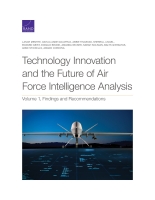by Lance Menthe
What are the challenges within the current enterprise?
How can tools and technologies — including AI/ML methods, available today or in the foreseeable future — help the AF DCGS evolve to meet the challenges of synthesizing data effectively and efficiently?
How might AI/ML be used and how can it help lay out a road map for incorporating technologies as they become available?
There is growing demand for the Air Force Distributed Common Ground System (AF DCGS) to analyze sensor data. Getting the right intelligence to the right people at the right time is increasingly difficult as the amount of data grows and timelines shrink. The need to exploit all collections limits the ability of analysts to address higher-level intelligence problems. Current tools and databases do not facilitate access to needed information.
Air Force/A2 asked researchers at RAND Project AIR FORCE to analyze how new tools and technologies can help meet these demands, including how artificial intelligence (AI) and machine learning (ML) can be integrated into the analysis process. PAF assessed AF DCGS tools and processes, surveyed the state of the art in AI/ML methods, and examined best practices to encourage innovation and to incorporate new tools.
Key Findings
Many analytic tasks can be fully or partially automated, although human involvement will continue to be necessary in more-complex tasks.
AI/ML can free analysts to focus on solving intelligence problems and developing supporting technologies to make analysis more efficient.
Analysts will require new skills both to facilitate use of AI/ML and to take advantage of opportunities to conduct more-advanced analysis.
Recommendations
AF DCGS should leverage existing technologies to automate some analysis and reporting tasks and to make archival intelligence more accessible.
AF DCGS should take advantage of AI/ML technologies, when available, for early phase analysis tasks (e.g., identifying and tagging imagery, issuing threat warnings, re-tasking collectors).
AF DCGS should organize to balance human effort across three competencies: supporting missions, supporting analysis, and solving intelligence problems.
AF DCGS should recruit and train analysts with data science, programming, and other skills.
AF DCGS should follow best practices for developing, implementing, and sustaining new tools.

No comments:
Post a Comment